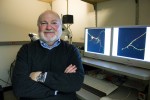Professor David Glanzman’s research proposes the idea that memory restoration in neuron synapses is possible through experimentation with snails. The results of his research may help in fighting the battle with Alzheimer’s disease and dementia.
—
TRANSCRIPT:
SOT: David Glanzman is a professor in the department of Integrative Biology and Physiology and his research focuses on memory restoration in the brain synapses. Through the use of snails, he believes that memory can be intact even if the synapses are destroyed.
GLANZMAN: The snails that we use, their latin names are Aplysia californica, and they live here in California inshore and you can see them in tide pools all up and down in Southern California.
SOT: On the second floor of the Gonda Neuroscience and Genetics Research Center on Charles E. Young Drive South, Dr. David Glanzman leads me to a small room down the hall from his lab. I spot water tanks that are adjacent to the wall that contains curious specimens inside. They are snails, and they play a crucial part in Dr. Glanzman’s research. In his lab, these large snails are used to do the research due to their uniquely large neurons because the size of the neurons makes them easier to observe in cell culture.
GLANZMAN: We use these animals because they have a very simple nervous system. Their central nervous system has about 20,000 neurons and by comparison our central nervous systems have about 100 billion neurons; it’s much simpler than ours. Another advantage to using them – and this is particularly true for electrophysiological analysis of learning and memory – is that they have very large neurons.
SOT: Dr. Glanzman’s research relates back to Alzheimer’s disease where the synapses in the brain are destroyed, causing memory loss. His research provides a possibility of retrieval for the lost memories, believing that the memories can come back if the synapses are restored.
GLANZMAN: During Alzheimer’s disease, one of the things that happens during the early stages is that there is massive destruction of synapses in people’s brain and an implication of our result is that the destruction of those synapses does not necessarily mean the destruction of the memories. The synapses can be destroyed but the memories may still be intact. You may be able to restore those memories if we can figure out a way to restore the synaptic connection.
SOT: Dr. Jesse Rissman is an assistant professor in the UCLA Psychology Department whose research focus is memory. According to him,Retrieval of memory is complex, and takes many parts of the brain to use.
RISSMAN There are different kinds of memory that one can retrieve, can retrieve a detail from a past experience in your life, this would be what psychologists would refer to an episodic memory. Another kind of memory that one can retrieve is what one refers to is semantic; this is just a memory for factual knowledge.
SOT: Rissman uses two examples of different kinds of memory, one called episodic and the other semantic. Episodic memory is where you retrieve a memory from your past, whether it be where you were, or who you were with. Semantic memory deals with facts and remembering dates or word definitions. However, whether episodic or semantic, diseases like Alzheimer’s and dementia cause memories to become more difficult to retrieve as one ages.
TAN: Aging is one of the main risk factors for developing Alzheimer’s and other forms of dementias. Although Alzheimer’s can occur in patients in their 30’s or 40’s, typically the incidents goes up after the age of 65 and up to 50% of people over the age of 85 actually have Alzheimer’s or other types of dementias.
SOT: That was Dr. Zaldy Tan who is director of UCLA Alzheimer’s and Dementia Care Program and associate professor at the David Geffen School of Medicine. Alzheimer’s disease tends to occur in old age, effecting how one is able to retrieve memory from the past and eventually leading to forgetting memories altogether.
TAN: Alzheimer’s disease is a neurodegenerative disease, meaning abnormal proteins accumulate in the brain which causes nerve cells to die and affects primarily parts of the brain that controls memory, initially short-term memory and eventually long-term memory, but also affects part of the brain that controls swallowing, and as well as walking coordination so eventually these systems will be affected as well.
SOT: Dr. Glanzman believes that the results of his research will unlock important clues to reversing the effects of Alzheimer’s disease.
GLANZMAN: I think by studying this restoration of synaptic connections after a synaptic erasure in the snail we’ll be able to get insights into how one might be able to about doing that.
SOT: Through his research with snails, Dr. Glanzman hopes to discover clues to fighting Alzheimer’s disease and restoring memory.
For Daily Bruin Radio, this is Nora Sot.
